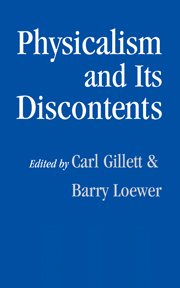Book contents
- Frontmatter
- Contents
- Contributors
- Preface
- Part I Physicalism
- Part II Physicalist Discontents
- 9 The Roots of Reductionism
- 10 The Significance of Emergence
- 11 The Methodological Role of Physicalism: A Minimal Skepticism
- 12 Physicalism, Empiricism, and Positivism
- Part III Physicalism and Consciousness: A Continuing Dialectic
- References
- Index
9 - The Roots of Reductionism
Published online by Cambridge University Press: 02 November 2009
- Frontmatter
- Contents
- Contributors
- Preface
- Part I Physicalism
- Part II Physicalist Discontents
- 9 The Roots of Reductionism
- 10 The Significance of Emergence
- 11 The Methodological Role of Physicalism: A Minimal Skepticism
- 12 Physicalism, Empiricism, and Positivism
- Part III Physicalism and Consciousness: A Continuing Dialectic
- References
- Index
Summary
Humans live in quotidian contexts. We plan trips, cook meals, and do the wash. Our time is spent within narrow boundary conditions. Our thought needn't stray from the commonplace. Our expectation needn't stray from everyday possibility. For this reason, we're disposed to mistake the contours of quotidian possibility for those of intelligibility. Yet the resulting bias is a kind of modal tunnel vision. We overlook certain conceptual possibilities. We discharge others due to their alien face alone.
In this note, I locate four features of everyday life. They generate blinkered expectation that large builds from small without remainder. I note they're contingent features of reality at best, discuss how they might fail, and use that discussion to unearth quotidian bias in two spots. First, I claim the stock argument for physicalism rests on unsound presuppositions induced by everyday life; second, I claim the stock expression of physicalism is modally misguided due to such presupposition as well.
The Roots
Everyday life renders common sense reductively oriented. There are four reasons why. Three are widely recognized. The fourth is not.
(A) In quotidian contexts: the large is the small writ big, and the small is the large writ small. Conceptually identical phenomena appear on different levels of scale. For instance: large-scale objects have shape, and so do their smaller cousins; large-scale objects have color, and so do their smaller cousins; large-scale objects move, and so do their smaller cousins. Differences across level are not differences of type. They are differences of scale alone. One range of concepts is apt for both levels. Large and small are conceptually homogenous (LASCH).
[…]
- Type
- Chapter
- Information
- Physicalism and its Discontents , pp. 197 - 206Publisher: Cambridge University PressPrint publication year: 2001



